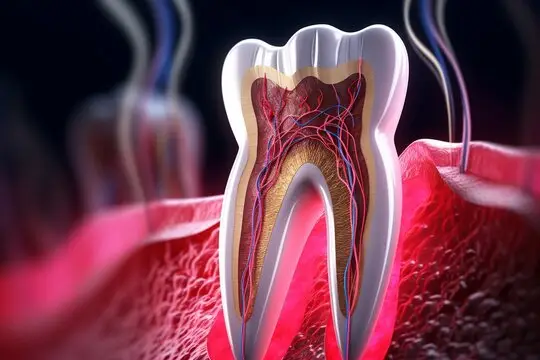Endodontics
Root Canal Therapy and Related Procedures
Root Canal Therapy (RCT) and related procedures, such as post and core placement, apicoectomy, and mesiotomy, are crucial in the field of endodontics. They address issues with the dental pulp and help restore teeth to optimal function and health. Root Canal Therapy is a procedure designed to treat infections or damage to the dental pulp, the soft tissue inside the tooth that contains nerves and blood vessels. The goal is to save the tooth and restore its function.

Procedure:
- Diagnosis: X-rays and clinical exams assess the extent of damage or infection.
- Preparation: The tooth is numbed, and an access opening is made in the crown.
- Cleaning and Shaping: The pulp chamber and root canals are cleaned, disinfected, and shaped.
- Filling and Sealing: The cleaned canals are filled with a biocompatible material (usually gutta-percha) and sealed.
- Restoration: A crown or other restoration is placed to protect and strengthen the tooth.
Post and Core
Post and Core are used to provide additional support and stability for a tooth that has undergone extensive restoration, particularly after a root canal treatment.
- Post
- Description: A post is a small rod, usually made of metal or fiber-reinforced resin, placed into the root canal to provide anchorage for a crown or other restoration.
- Types:
- Metal Posts: Made from materials like stainless steel or titanium, offering strong support.
- Resin Posts: Made from fiber-reinforced resin, which blends with the tooth and can be more aesthetic.
- Core
- Description: A core is a build-up material placed around the post to form a foundation for the crown. It fills the remaining space inside the tooth and supports the restoration.
- Materials: Core materials can be made from composite resins, amalgam, or glass ionomer, depending on the clinical needs.
Procedure:
- Post Placement: The dentist drills a small hole in the root canal and inserts the post.
- Core Build-Up: A core material is placed around the post to build up the tooth structure.
- Crown Placement: A crown is placed over the core to restore the tooth’s function and appearance.
Apicoectomy
Apicoectomy is a surgical procedure performed when a root canal treatment fails, or there is persistent infection at the tip of the tooth root.
Procedure:
- Incision: The gum is cut to access the root tip.
- Removal of Infected Tissue: The infected tissue at the root tip is removed.
- Retrograde Filling: A filling is placed at the root tip to seal the end of the root canal and prevent further infection.
- Suturing: The gum is sutured back in place.
Benefits:
- Provides a last resort option to save a tooth when traditional root canal therapy is not sufficient.
- Helps alleviate persistent pain and infection.
Mesiotomy
Mesiotomy is a less common endodontic procedure involving the removal of the mesial (inner) portion of a tooth’s root to access and treat internal issues.
Procedure:
- Incision: A small incision is made in the gum to expose the tooth’s root.
- Removal of Mesial Portion: The mesial root portion is removed to access the internal structures.
- Treatment: The root canal is cleaned, treated, and filled as needed.
- Restoration: The tooth is restored with a core and crown as necessary.
Benefits:
- Allows access to root canals that may be difficult to treat using conventional methods.
- Can save a tooth that might otherwise require extraction.
Summary
- Root Canal Therapy (RCT): A procedure to remove infected or damaged pulp, clean, and seal the root canals, followed by restoration with a crown or filling.
- Post and Core: Support structures used to strengthen and restore a tooth after RCT, with options for metal or resin posts and various core materials.
- Apicoectomy: Surgical intervention to address persistent infection at the root tip after failed root canal treatment.
- Mesiotomy: A surgical procedure to remove part of the tooth’s root for access to and treatment of internal issues.
These procedures are integral to endodontics, providing solutions to preserve and restore teeth affected by pulp damage, infection, or structural issues.
